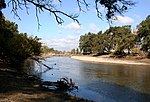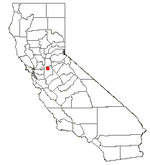Woodbridge Masonic Lodge No. 131
Buildings and structures in San Joaquin County, CaliforniaClubhouses on the National Register of Historic Places in CaliforniaGothic Revival architecture in CaliforniaMasonic buildings completed in 1882Masonic buildings in California ... and 2 more
National Register of Historic Places in San Joaquin County, CaliforniaSan Joaquin Valley Registered Historic Place stubs

The Woodbridge Masonic Lodge No. 131 is a historic building located in Woodbridge, California. The building was designed by architect Charles Beasley and was built in 1882 to serve as a meeting hall for Woodbridge Lodge No. 131, a local chapter of the Freemasons.The building was listed on the National Register of Historic Places in 1989. The building was described in its NRHP nomination as "a unique example of the nineteenth century Gothic Revival style...expressed in a very controlled and geometric [way]."
Excerpt from the Wikipedia article Woodbridge Masonic Lodge No. 131 (License: CC BY-SA 3.0, Authors, Images).Woodbridge Masonic Lodge No. 131
Lower Sacramento Road,
Geographical coordinates (GPS) Address Nearby Places Show on map
Geographical coordinates (GPS)
| Latitude | Longitude |
|---|---|
| N 38.153888888889 ° | E -121.30083333333 ° |
Address
Woodbridge Uncorked
Lower Sacramento Road 18911
95258
California, United States
Open on Google Maps







